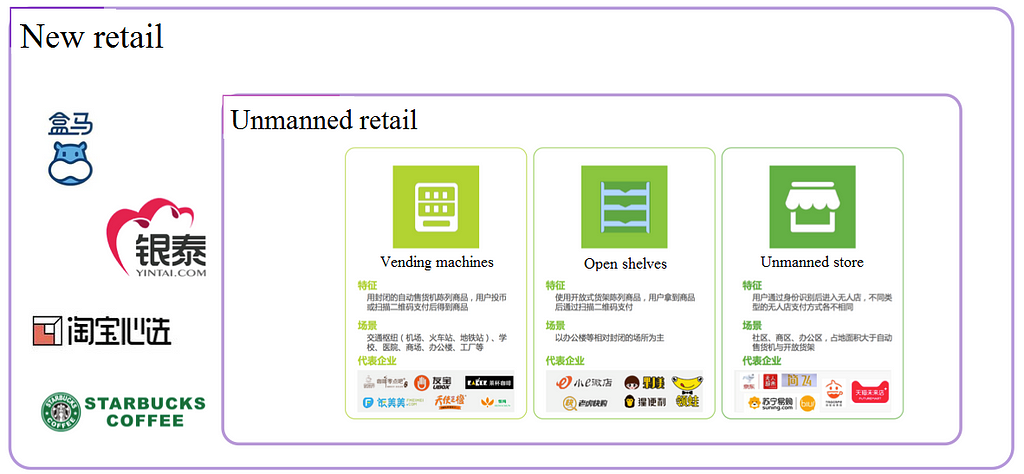Latest news about Bitcoin and all cryptocurrencies. Your daily crypto news habit.
Alibaba’s the Tmall Future Store shows how technology can help offline merchants thrive in the e-commerce age
If you’ve ever waited in line impatiently to pay for groceries, chances are you’ve wished you could escape the typical service experience we all tend to encounter as shoppers. While delivery and e-commerce services offer one alternative for people hoping to avoid the hassle, a more recent effort at Alibaba is making it likely that you’ll soon be shopping in stores that let you walk in, grab what you need, and pay automatically as you walk out, simplifying retail for shoppers and merchants alike.
To showcase its progress, Alibaba recently unveiled an experimental 80-square meter installation of its new Tmall Future Store at the 2018 Yunqi Computing Conference, inviting attendees to explore a convenience store without a single employee on staff. Inside, they were able to browse for food, snacks, and beverages while getting help as needed from a digital T-guide assistant, then settle their bills by simply exiting the premises.
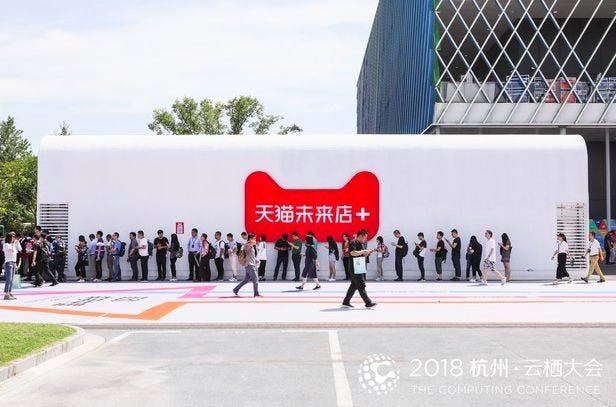 Visitors line up outside Alibaba’s Tmall Future Store at the 2018 Yunqi Computing Conference
Visitors line up outside Alibaba’s Tmall Future Store at the 2018 Yunqi Computing Conference
To further highlight this new mode of shopping, senior technical expert Shi Wei of Alibaba’s Taobao Technology Department addressed the conference with a speech covering where the emerging field of new retail has been so far and where it is going next. Inside, we look at highlights of his speech and explore the technology that is helping make unmanned retail a crucial part of that evolution today.
From New Retail to Unmanned Retail
While Tmall’s unmanned Future Store presents an entirely new paradigm for shopping, it is only one part of a broader movement to upgrade offline shopping through new technologies, business models, and channels, known together as ‘new retail’.
At the most basic level, new retail ranges from vending machines that accept mobile payments to the cheap, open-shelved mini shops many workplaces now offer thanks to digitalized business models that expedite stocking and reduce overhead. On a larger scale, it also encompasses supermarkets like Alibaba’s Hema that combine features of online and offline commerce, as well as cooperative ventures with independent retailers like Starbucks. At the heart of new retail is data, and ways it can be used to reduce pain points for consumers and merchants alike in traditional retail settings.
Market analysis indicates that early efforts to remove human workers from retail have been met with mixed reactions from consumers. Nevertheless, the output value for such ventures in China is predicted to rise from RMB 20 billion in 2017 to RMB 65 billion in 2020, driven mainly by rising labor costs, offline operating costs, and consumer demand. With technology now able to support the truly futuristic experience the Tmall Future Store captures, unmanned retail can focus on giving consumers a whole new way to shop, rather than simply upgrading existing options.
According to an iResearch study of the Chinese market, 8.5 percent of the country’s consumers prefer to make purchases from human cashiers, while 23.7 percent prefer to scan a code as they leave the store. Beyond this, 29.8 percent prefer to pick up goods from a smart settlement basket that they retrieve at the exit, while an overwhelming 39 percent would prefer to simply walk out with their groceries in a form of automatic settlement. Having cleared the initial hurdle of cultivating demand for experiences like the Tmall Future Store, Alibaba has since been able to focus on the ways its new model can enhance business for its partners, as well as the efficiency of labor in the broader marketplace.
In one instance, moving the group’s Alicool souvenir shop to a completely automated framework increased annual turnover by 75 percent and sales volume by 20 percent, attracting 56 percent more consumers than during the previous year. At just 120 square meters, the store is now able to handle as many as 2,300 visitors per day, largely owing to the average 4.5 seconds it takes shoppers to complete automatic settlement when exiting.
In another example, Alibaba collaboratively renovated the Zhida Bookstore in Shanghai to enable automatic facial recognition-based settlement, greatly increasing the store’s daily turnover. Notably, Alibaba was able to apply findings from previous efforts to complete the installation of the new facilities in just 53 days, raising the store’s daily turnover by 78.3 percent.
A Look Inside the Tmall Future Store
With the Tmall Future Store, Alibaba has entered a phase it calls ‘unmanned retail 2.0’, significantly expanding on the capabilities Alicool and the Zhida Bookstore demonstrate. As well as a technical upgrade, the new phase involves a shift of emphasis from impressing customers to attracting existing merchants to the concept.
Technically, the key advance captured in the Tmall Future Store is computer vision. Upon first entering the shop, customers scan a code with their phones to establish their virtual presence there. Once they have done so, a series of roughly 100 screens will respond as they move through the store, making personalized recommendations and providing directions to help locate items. At shelves, the system uses gravity sensors and built-in cameras to identify and add goods to customers’ virtual shopping carts. This enables customers to simply leave when ready, as the system will automatically collect payment for any items which have not been returned as they exit. To document these transactions, the system generates a virtual bill which appears in customers’ Alipay or Mobile Taobao accounts, and the items in the virtual bill will also include links for repurchasing if they are available online.
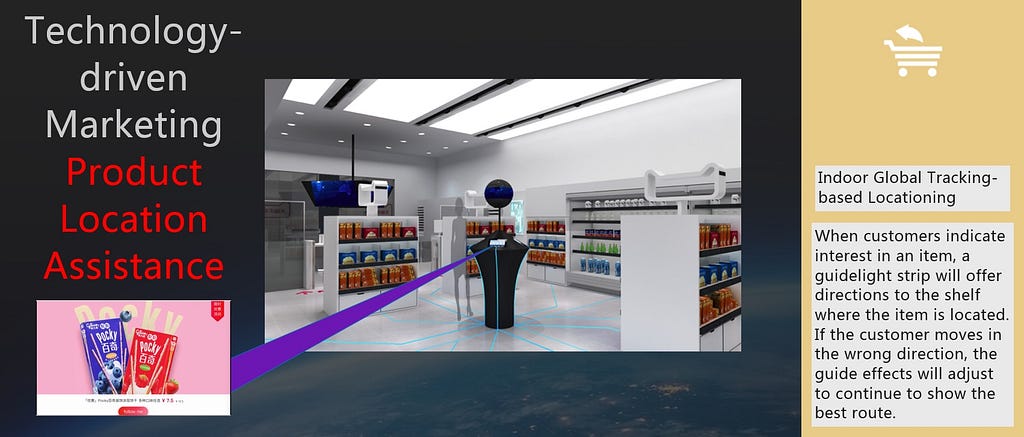 A view of customer guidance systems inside the Tmall Future Store
A view of customer guidance systems inside the Tmall Future Store
As a whole, this user experience traces the interaction of three core systemic capabilities: global tracking, product identification, and user-item matching. The last of these is by far the most critical, as any confusion that results in a payment being deducted from the wrong customer can invalidate the idea that automation can replace human services. In an example of how this can happen, visitors to the store at the conference occasionally crossed arms reaching for items, swapped items, or offered to help each other return items, challenging the algorithm to sort out conflicting digital impressions.
The best solution to such problems is prevention through the effective digitalization of offline behavior, presenting an ongoing challenge for developers as they seek to make these novel capabilities fully marketable.
Continuing Development for the Future
In its present state, the Tmall Future Store introduces a coherent “6+1” technical architecture, in which five processing ends and a local gateway interact together with a coherent set of business priorities — namely transaction, processing, operating, and data storage in the cloud. While anyone hoping to open a store could work from this architecture, preparing it for widespread marketing still requires the targeted improvement of algorithm capabilities, reduction of hardware costs, and reduction of deployment costs.
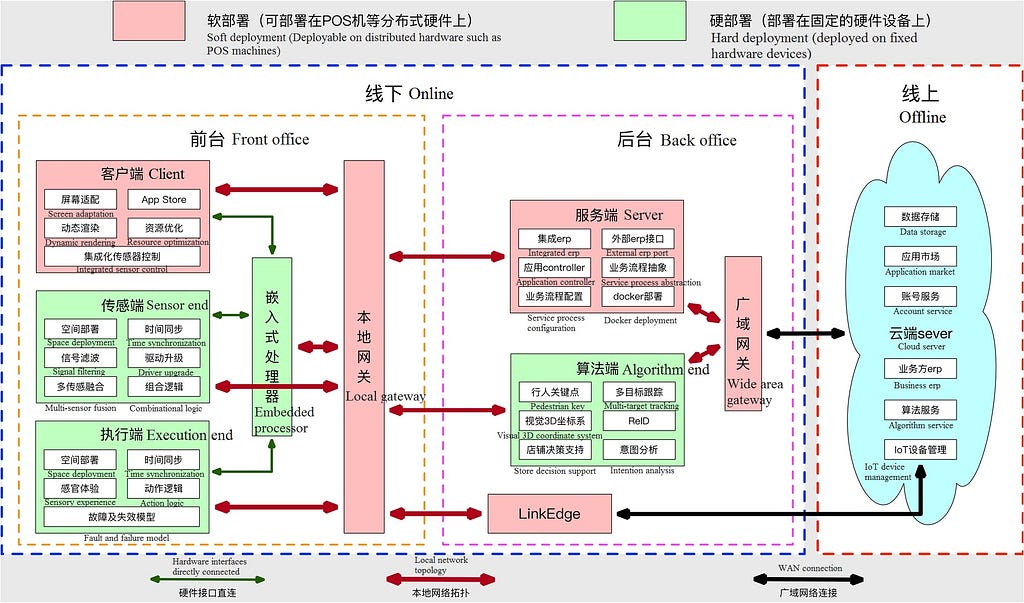 An overview of Alibaba’s most recent architecture for unmanned retail environments, now undergoing further development
An overview of Alibaba’s most recent architecture for unmanned retail environments, now undergoing further development
One current example of an algorithmic limitation is the need for customers to cooperate with sensors by standing still while selecting items or completing settlement. Ideally, scanners should be equipped to handle some amount of motion or other variations, presenting a complex deep learning problem for optimization. Further, the system’s facial recognition component uses an initial scan image of each customer as a “one-off” point of reference. As even human observers may struggle to tell whether two images from different angles show the same person’s face, refining the recognition algorithm poses formidable challenges.
Another outstanding challenge is to make algorithms more adaptable across environments, as each new unmanned store requires deploying and training the model to work within its specific dimensions and conditions. The key to doing so is separating the tuning of specific parameters from the model, which can be done using information gathered through the repeated deployment of its environmental sensors in different environments.
In terms of market entry barriers, hardware costs remain preventive, not because they must be high but because the processing challenges developers currently face place heavy demands on equipment. Moreover, transforming a traditional brick-and-mortar shop into an unmanned store takes up a great deal of time, as engineers need to work on a by-case basis to update devices and systems one by one.
To reduce costs, Alibaba is working to narrow down the functionality of devices. Because the cost of increasing computing power is not linear, boosting central server power to cover more end functions is not viable in the age of edge computing. To counter this, cameras and screens deployed in unmanned stores will need upgrades to their own computing power.
Another cost reduction approach in the works is device standardization. By making all devices replaceable, repairable, and consistent, developers hope deployment and maintenance processes can be streamlined and standard procedures enabled. This would allow for a robotic approach to off-hours maintenance and inspection for both hardware and AI.
With the ultimate goal of establishing a device management system, developers are seeking applications for an Alibaba Cloud product called Linkedge, which can be used to develop a hot-swappable HAL layer for the framework that uploads and downloads device information for monitoring. In effect, this means the system will be remotely upgradable, deployable across different devices, and primed for the addition of new functions — in short, perfectly suited to the mobile era.
Looking Ahead
To summarize the importance of the Tmall Future Store, Alibaba’s Shi Wei described it as an offline Taobao designed to be as interactive as the mobile phones that shoppers carry in with them. Like the first wave of online commerce that Taobao emerged with, it is offering new ways to study people’s habits and preferences as shoppers, making stores both a laboratory for understanding economic activity and a setting for putting that knowledge to use.
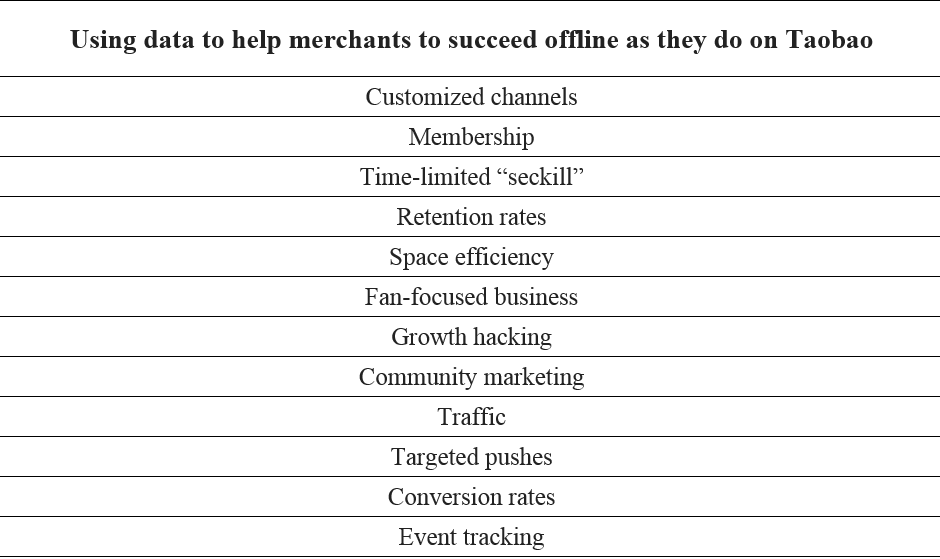 Some of the many ways data from unmanned retail stores can help merchants thrive
Some of the many ways data from unmanned retail stores can help merchants thrive
With the rise of e-commerce, many have voiced fears that platforms like Taobao will eventually make offline retail obsolete. With its Tmall Future Store, Alibaba is showing how the technology enabling it might instead be used to improve business for offline merchants, helping them to make smarter choices and better returns on investment. As a first step in unmanned retail, its completion should provide a valuable foundation for developments to come.
Alibaba Tech
First hand and in-depth information about Alibaba’s latest technology → Facebook: “Alibaba Tech”. Twitter: “AlibabaTech”.
New Meaning to Grab and Go: Alibaba Unveils its Unmanned Store was originally published in Hacker Noon on Medium, where people are continuing the conversation by highlighting and responding to this story.
Disclaimer
The views and opinions expressed in this article are solely those of the authors and do not reflect the views of Bitcoin Insider. Every investment and trading move involves risk - this is especially true for cryptocurrencies given their volatility. We strongly advise our readers to conduct their own research when making a decision.

